A Cambodian maternity patient was brought to FV Hospital in Vietnam for emergency care after she bled uncontrollably after giving birth in her homeland, putting her life at serious risk.
FV doctors identified the cause of the bleeding as acquired haemophilia, an extremely rare condition, especially in women, that affects the blood’s ability to clot. The Hospital’s medical team worked tirelessly for over a month to save the patient’s life.
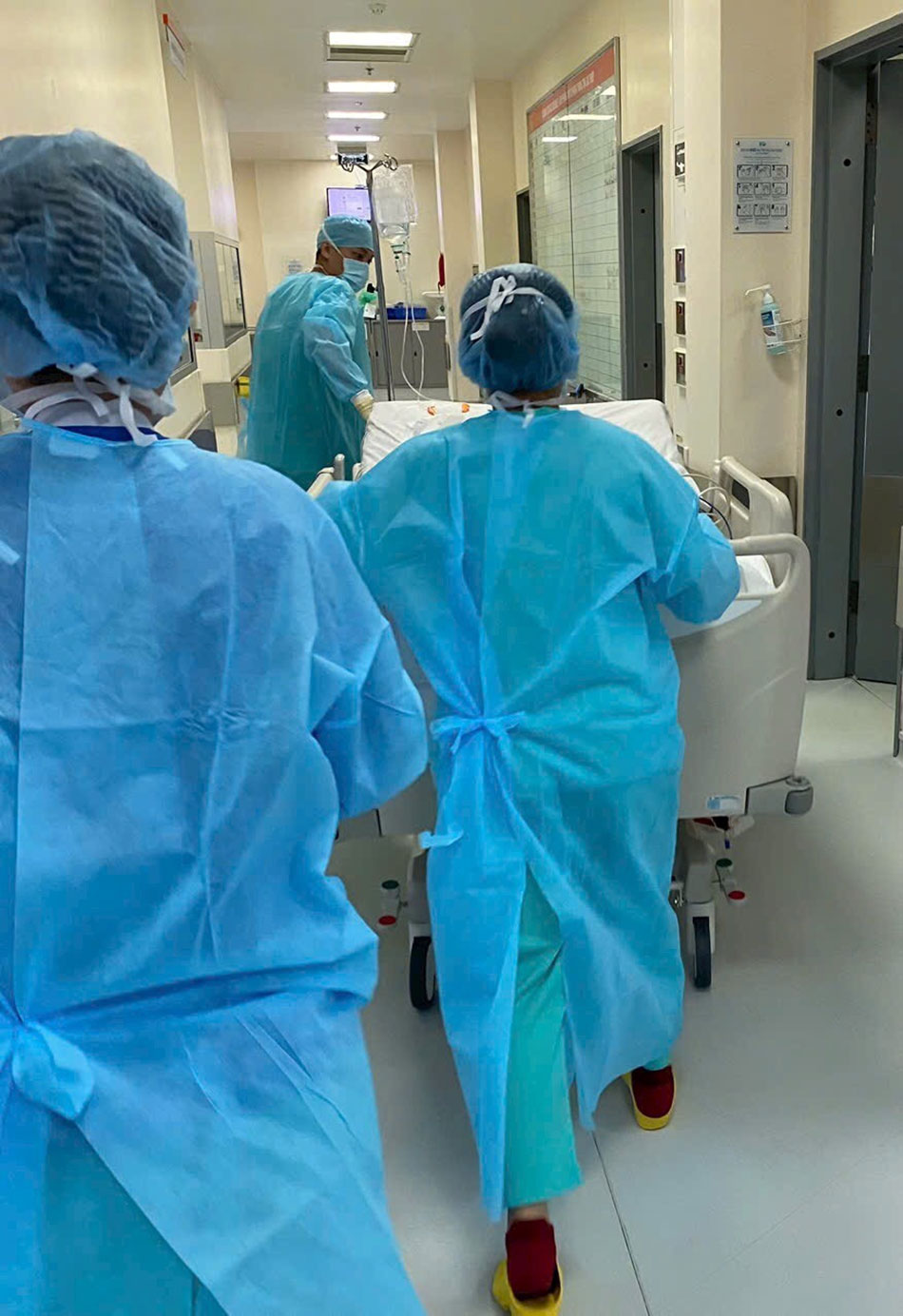
Dr Tuan and the team promptly take the patient to the operating room.
A maternity patient is in critical condition due to profuse, incessant postpartum bleeding.
On the day Mr Muth Sothya (38 years old) brought his wife (Ms Chhun Setina, 36 years old) to the hospital in their hometown in Cambodia for her third delivery, he did not anticipate that his wife would face a serious complication. After giving birth via C-section, she developed a fever and began bleeding uncontrollably.
On October 18, suspecting a haematoma, a serious form of bruising, doctors performed surgery to address the issue. Instead, unable to stem the source of the bleeding, doctors performed a hysterectomy, a surgical procedure to remove Ms Setina’s uterus. Unfortunately, she continued to bleed. After a second surgery the following day, doctors were still unable to control the bleeding.
Mr Sothya was devastated when the doctors informed him that there was nothing they could do, and that no other hospital in their hometown could provide the care his wife needed. Desperate, he sought their help to contact doctors in Vietnam to find a way to save Ms Setina but after contacting several major hospitals, they hadn’t found one that would accept her as a patient.
Finally, through the representative office of FV Hospital in Phnom Penh, Ms Setina was accepted by FV Hospital. As the bleeding persisted, Cambodian doctors placed two large gauze pads, measuring around 20 cm, into the patient’s abdomen and resutured the incision before transferring her to Vietnam as an emergency case to be admitted to FV Hospital. Meanwhile, FV’s leadership and medical team held an emergency meeting to prepare to admit Ms Setina.
Efforts to control blood bleeding by the surgical team.
Ms Setina arrived at FV Hospital on the night of October 21 and treated by Dr Le Duc Tuan‘s General Surgery team. X-rays clearly showed two large gauze pads in the patient’s abdominal cavity, which were immediately removed during an emergency surgery as leaving them in place for too long posed a high risk of abdominal infection. Doctors found two litress of blood pooled in Ms Setina’s abdominal cavity. A human body typically contains around 10 units of blood, roughly 5600 ml. According to medical records, Ms Setina had already received a total of 32 units of blood in Cambodia, equivalent to more than 18 litres.
Dr Tuan, an experienced surgeon, couldn’t help but feel deeply saddened when confronted with a very young mother with an abdomen marked by multiple surgeries. “A surgeon must have the heart of a lion, but there are still situations that make the heart ache,” he shared.
Subsequently, the FV doctors discovered that damage to the left subclavian artery had not been properly addressed, so they took extra care to control the bleeding. The surgery was executed flawlessly, but before they could celebrate, the surgical team found blood was still seeping from Ms Setina’s body.
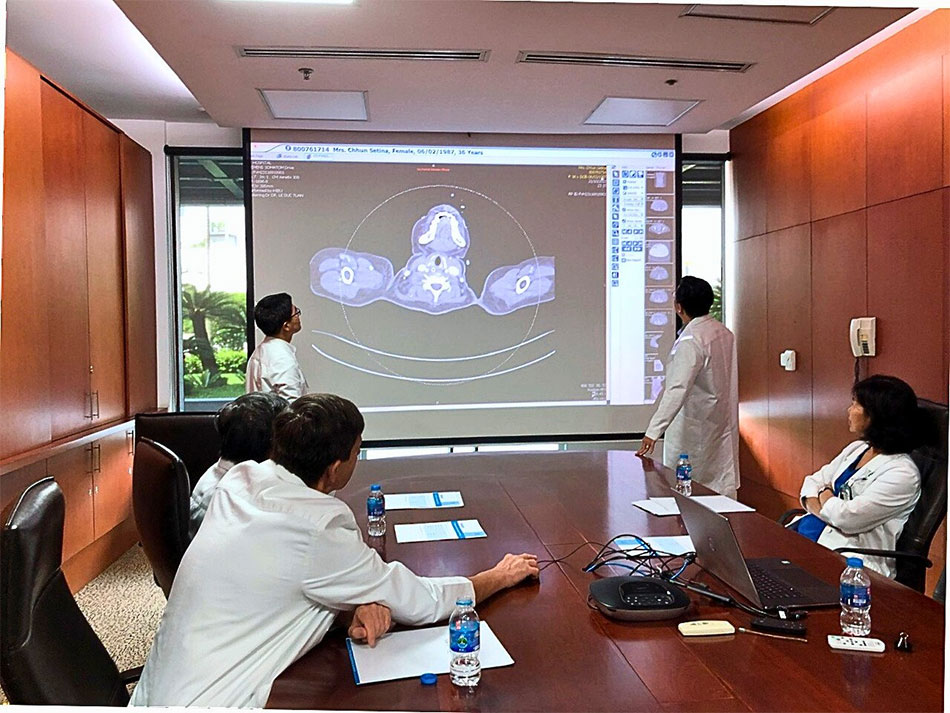
FV organised several interdisciplinary consultation sessions during the course of Mr Setina’s treatment.
An emergency multidisciplinary consultation was called to investigate the cause of the continuous bleed. The patient’s abdominal area, after being repeatedly operated on, was lasered to control blood loss and sutured multiple times, creating a challenging mass that made it difficult to access the source of bleeding.
The medical team decided to switch to an arterial intervention to occlude, or fully obstruct, the damaged branches of the subclavian artery in the patient’s abdominal area to prevent further blood loss.
The arterial intervention was performed by Dr Pierre Jaillot, Head of the Imaging Department at FV Hospital. When approaching the subclavian artery on the left side, Dr Pierre encountered difficulties in navigating the artery.
At that moment, Dr Luong Ngoc Trung, Head of the Thoracic, Vascular & Endovascular Surgery Department, who was on standby to assist the surgery, was invited to participate in the arterial intervention. Investigating the cause, Dr Trung observed that the subclavian artery and the brachial artery were constricted due to the patient being given a high-dose vasoconstrictor to raise her blood pressure after previous surgeries. Dr Trung attempted to intervene the artery via the axillary region, under the patient’s shoulder, descending to the patient’s abdominal area. He was successful and the arterial intervention proceeded smoothly, culminating with the surgical team tying off the artery.
Four vials of a rare medication were urgently sourced to treat this rare blood clotting disorder.
However, 12 hours later, Ms Setina was still bleeding. FV Doctors continued to administer blood and blood products, initially 200ml, then 700ml, scaling to what amounted to a massive blood transfusion protocol. Whatever was transfused into the patient’s body seemed to leak out.
During more than 30 hours of internal treatment, the patient had bled incessantly. Nguyen Thi Lam Giang, a doctor at FV’s Anaesthesiology and ICU Department, suspected that Ms Setina had haemophilia, a rare blood clotting disorder that causes uncontrollable bleeding and primarily affects males. The strange thing was that if a female patient had this condition, she might die after her first menstrual period due to blood loss, while this patient had already given birth three times.
The team invited Dr Pham Manh Tuan, a haematologist at FV Hospital, for consultation. Dr Tuan also suspected that the patient might have some type of blood clotting disorder, so he ordered extensive specialist tests to facilitate her diagnosis.
Test results showed that Ms Setina’s blood was very low in Factor VIII, or antihaemophilic factor—the protein that is deficient or defective in patients with classical haemophilia and Von Willebrand syndrome. They also showed there was an inhibitor of Factor VIII, indicating that this was a rare case of acquired haemophilia. Acquired haemophilia is even rarer than congenital haemophilia, occurring in about one in every 1000 people each year and typically found in older patients with underlying conditions such as blood cancer. The fact that Ms Setina was young and female made it very unlikely that she would develop acquired haemophilia.
“In this patient, acquired haemophilia could be related to the pregnancy, but we still needed to screen for other causes,” explained Dr Pham Manh Tuan.
To treat this condition, Dr Tuan suggested using a bypassing agent in the form of Factor VII, another protein which is very expensive and only stocked by a few hospitals.
Immediately, Ms Setina’s treatment team collaborated with FV Hospital’s Pharmacy team to contact every hospital in Ho Chi Minh City, sourcing four units of Factor VII to infuse.
ICU doctors reported that after receiving injections of four tiny vials of Factor VII, patient Setina bleeding symptoms immediately ceased.
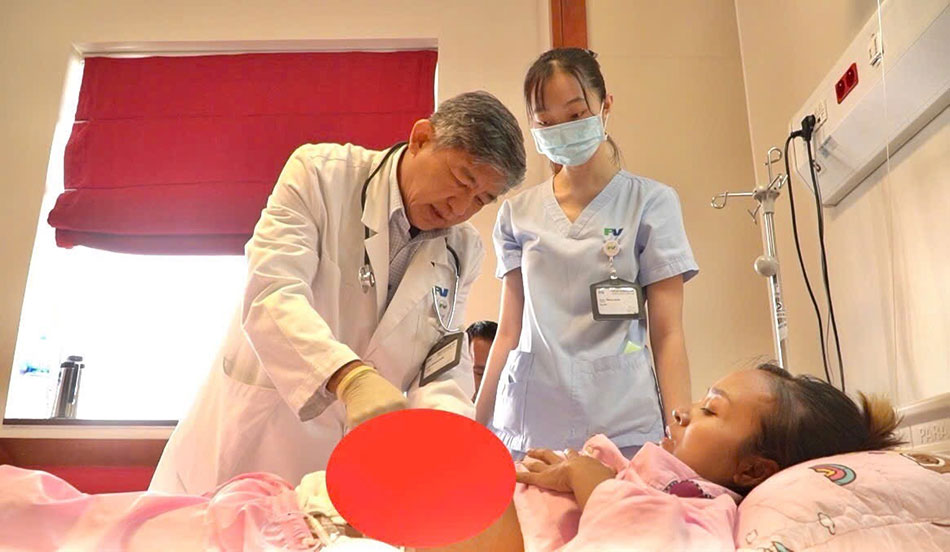
Dr Tuan examines Ms Setina and changes her dressings.
This case utilised all of the Hospital’s resources in the fight for the patient’s life.
However, Ms Setina’s treatment did not stop there. After multiple surgeries and suffering septic shock, she was very weak and had damage to her internal organs. She had developed pneumonia, a urinary tract infection, adrenal insufficiency, and asthma attacks. Her fever persisted for three consecutive weeks.
“Due to severe septic shock, the patient needed high-dose antibiotics, heart support medications, and vasopressors to raise her blood pressure. Ms Setina’s body was almost completely obscured by infusion pumps that administered vasopressors and supportive medications throughout her body,” said Dr Giang.
Subsequent consultations focused on treating infection and providing nutrition to enhance Ms Setina’s immune system. With each passing day her condition gradually improved, bringing joy to the entire medical team.
When asked what made FV and Dr Giang’s team confidently accept such a critical case with so many risks, Dr Do Trong Khanh, Medical Director of FV Hospital, replied: “When we received a call from our colleagues abroad requesting treatment on behalf of a patient, although we couldn’t be sure whether we could save the patient or not, I, on behalf of the Board of Directors, decided we must accept. The professional capabilities of FV’s medical team coupled with the most advanced equipment means that we have the best possible resources to handle complex cases and save a patient.”
FV has previously accepted dangerous, complicated cases, but Dr Khanh assessed this case as one of the most challenging the team has faced. “Ms Setina has three young children, one of whom was just born. If, unfortunately, she were not to survive, then these three children would become motherless orphans. This potential situation was at the forefront of every doctor’s mind when we accepted this case.”
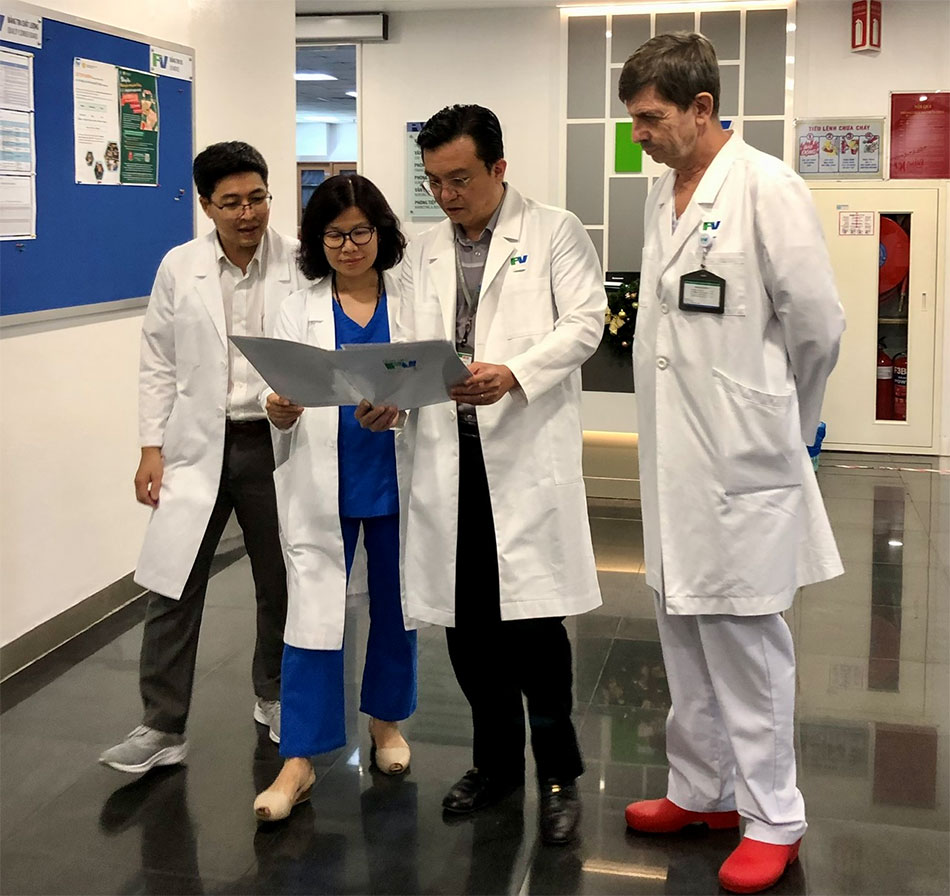
Multi-disciplinary coordination at FV creates valuable resources for the treatment of complex cases.
Throughout the month that Ms Setina was at FVH, more than 40 doctors participated in her care. Many multi-disciplinary meetings, both in-person and online, were held by doctors and leadership to closely monitor her progress. Doctors experienced tense moments and many sleepless nights.
“At FV, the strength of multiple specialties is crucial. Thanks to the quick coordination of various specialties in the hospital, we were able to save this patient who was in a critical situation!” Dr Tuan added.
“In Vietnam, I feel like I’ve been born again!”
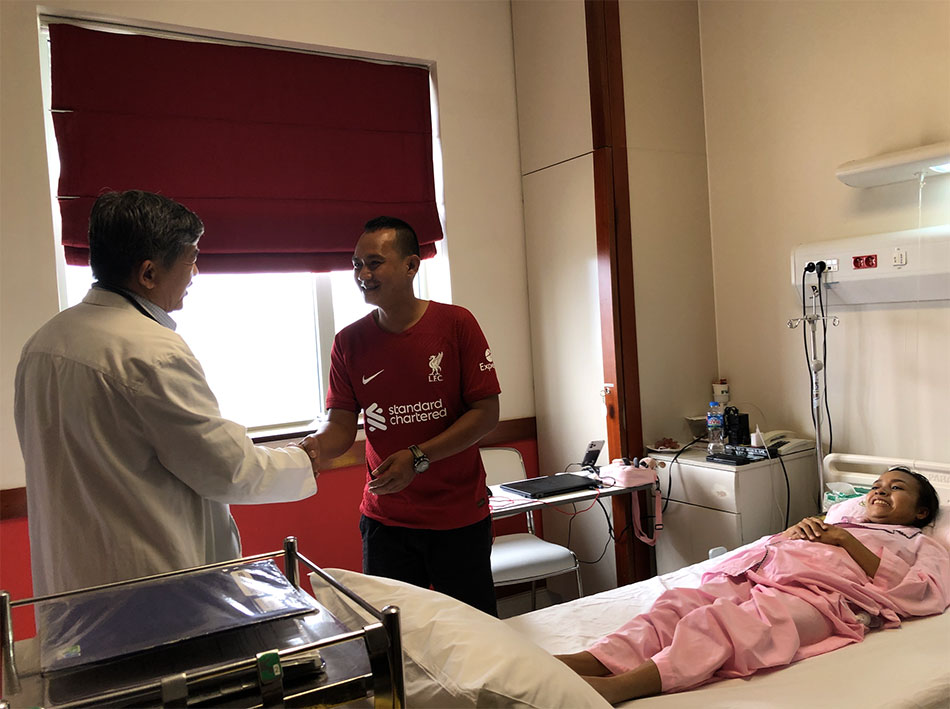
Mr Muth Sothya expresses gratitude to Dr Tuan and the FV Hospital team for saving his wife’s life.
On November 23rd, Dr Tuan conducted a check-up on Ms Setina. Her health had recovered remarkably well, allowing her to be discharged the following day.
Mr Muth Sothya tightly grasped Dr Tuan’s hand, overflowing with gratitude as his wife, the mother of their three young children, was not only alive but also returning home. Over the past few weeks, their extended family had anxiously followed the race against time led by FV Hospital doctors to reclaim his wife’s life. Mr Sothya understood that entrusting her to Vietnamese doctors was the right decision.
Upon hearing the news that she had recovered well enough to return home, Ms Setina expressed her happiness: “Thank you, Dr Tuan, and everyone at FV for saving me. In Vietnam, I feel like I’ve been born again!”



